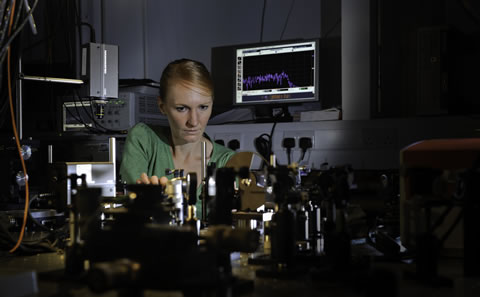Nonlinear Semiconductor Photonics

Headed by Professor Anna Peacock, the Nonlinear Semiconductor Photonics Group's focus is in the development of novel semiconductor waveguide platforms; from the design and characterisation stage, through to the demonstration of practical all-optical nonlinear devices.
The group has a full complement of experimental and numerical expertise to support the development, fabrication and application of a wide range of nonlinear photonic devices. It works in close collaboration with several groups across the Faculty of Engineering and Physical Sciences (FEPS) in particular, the Silicon Photonics group.
Research impact
Semiconductor photonics is fast becoming one of the most active areas of research and development as it has the potential to impact a wide range of important technology areas such as telecommunications, medicine, imaging, spectroscopy, and sensing.

Within this field, a subdivision that is gaining increased momentum is nonlinear semiconductor photonics, as the materials display a number of important nonlinear effects that can be used to generate and process light-based signals with unprecedented control.
Our research aims to develop elegant nonlinear semiconductor photonic devices fabricated from both conventional waveguides on-chip as well as those based on an emerging platform that incorporates the semiconductor materials directly into the cores of optical fibres. In particular, the semiconductor fibre platform opens a route to seamlessly link semiconductor technologies with the silica fibre infrastructures that are used to transmit light around the globe – one of the most important design challenges in the field.
Research facilities
A wide range of optical and material characterization facilities are available that extend over the wavelength range 300nm-3.4µm. Laser sources include: supercontinuum source, femtosecond optical parametric oscillator, high power fibre lasers and laser diodes.
Key research breakthroughs:
Nonlinear characterization of Ge-on-Si platforms in the mid-infrared
Key publications: 6776, 6904
Strain engineering the electronic bandgap of silicon core fibres
Key publication: 6687
Characterization of silicon microcylindrical resonators
Key publications: 5188, 5466, 6123
Nonlinear optical characterisation of hydrogenated amorphous silicon
core fibres.
Key publications: 4836, 5207, 5665, 5878
Tapered silicon optical fibres with tailored nonlinear and dispersion properties.
Key publications: 4712, 4747
Large mode area silicon microstructured fibres with robust dual mode guidance.
Key publications: 4504, 5135
Optical characterization of low loss semiconductor fibres.
Key publications: 4608, 4836
Current research projects
Laser-Engineered Silicon: Manufacturing Low Cost Photonic Systems
Funded by EPSRC (EP/M022757/1): Sept 2015 to August 2018
In collaboration with Dr S. Mailis (ORC) and Dr. H. Chong (ECS).
Project partners: Prof. N. Bulgakova and Prof. J. S. Aitchison.
Electronic-Photonic Convergence: A Platform Grant
Funded by EPSRC (EP/N013247/): Jan 2016 to Dec 2020
In collaboration with Prof. G. Reed (ORC), Dr G. Mashanovich (ORC), Prof. S. Saito (ECS) and Dr. H. Chong (ECS).
Mid-Infrared GeRmAnium phoTonIcs fOr seNsing (MIGRATION)
Funded by EPSRC (EP/L01162X/1): January 2014 to July 2016
In collaboration with Dr G. Mashanovich (ORC), Dr F. Gardes (ORC), Dr. H. Chong (ECS).
Project partner for the ARC funded project: Better vibrations: nonlinear sound-light interactions in semiconductor chips
Funded by ARC (DP160101691): January 2016 to Dec 2018
In collaboration with A/Prof. M. Steel, Prof. B. Eggleton, A/Prof. C. Poulton.
Visit our PhD projects page for further details.
Collaboration
Internal:
- Silicon Photonics group
- Computational nonlinear optics group
- Photonic systems circuits and sensors
- Microstructured optical fibres group
- Nanotechnology research group
- Laboratories for hybrid optoelectronics
Academic (international):
- Prof. J. Ballato (Clemson University, USA)
- Prof. U. Gibson (Norwegian University of Science and Technology, Norway)
- Prof. N. Bulgakova (HiLASE, Centre for the Institute of Physics, Czech Republic)
- Prof. B. Eggleton (University of Sydney, Australia)
- Prof. J. S. Aitchison (University of Toronto, Canada)
Work with us
If you are interested in working with us or would like to find out more about our group please contact Prof. Anna Peacock.